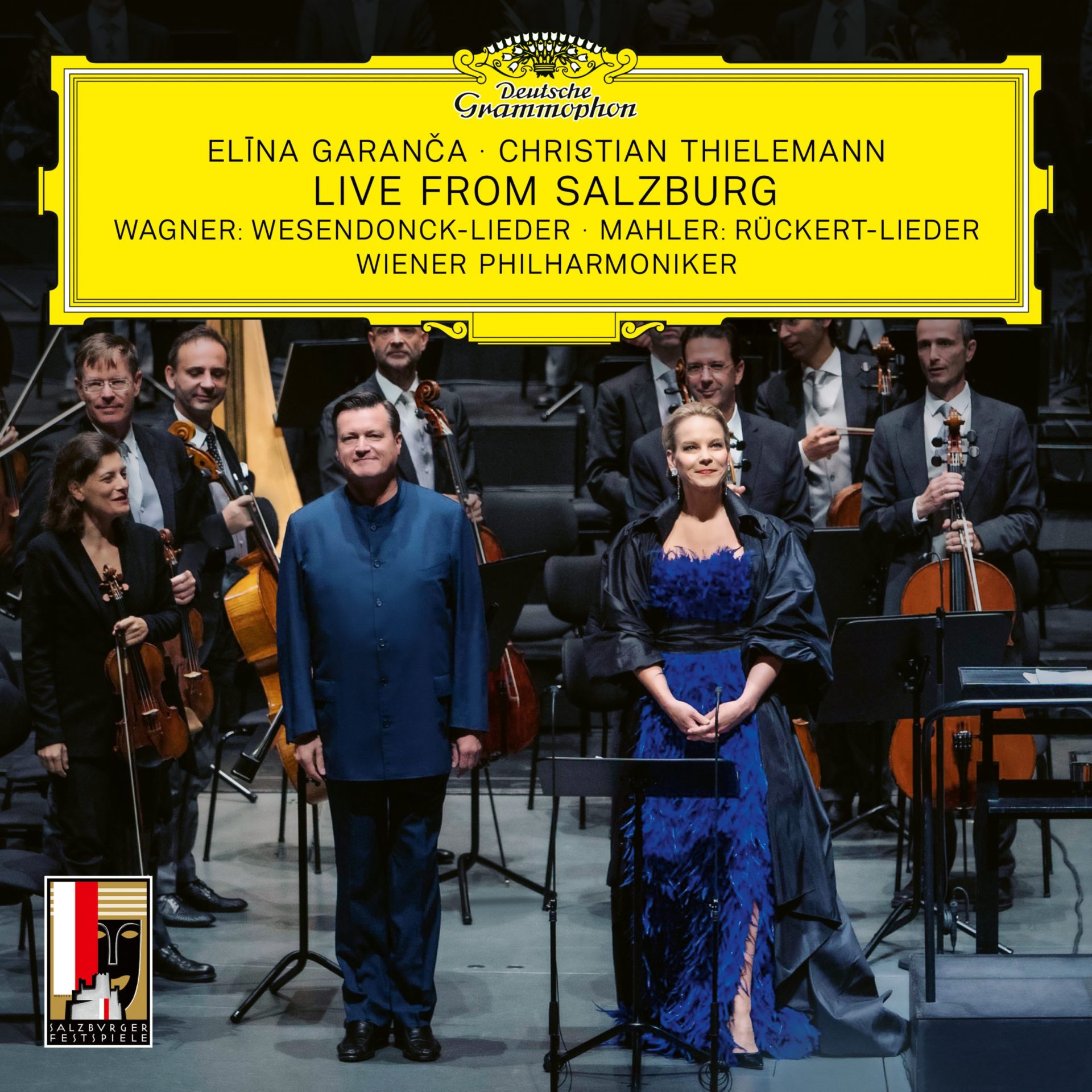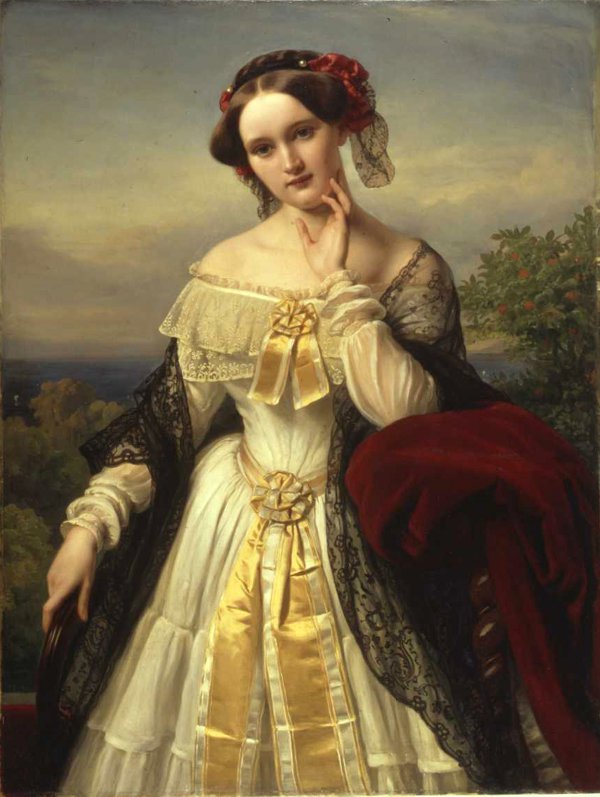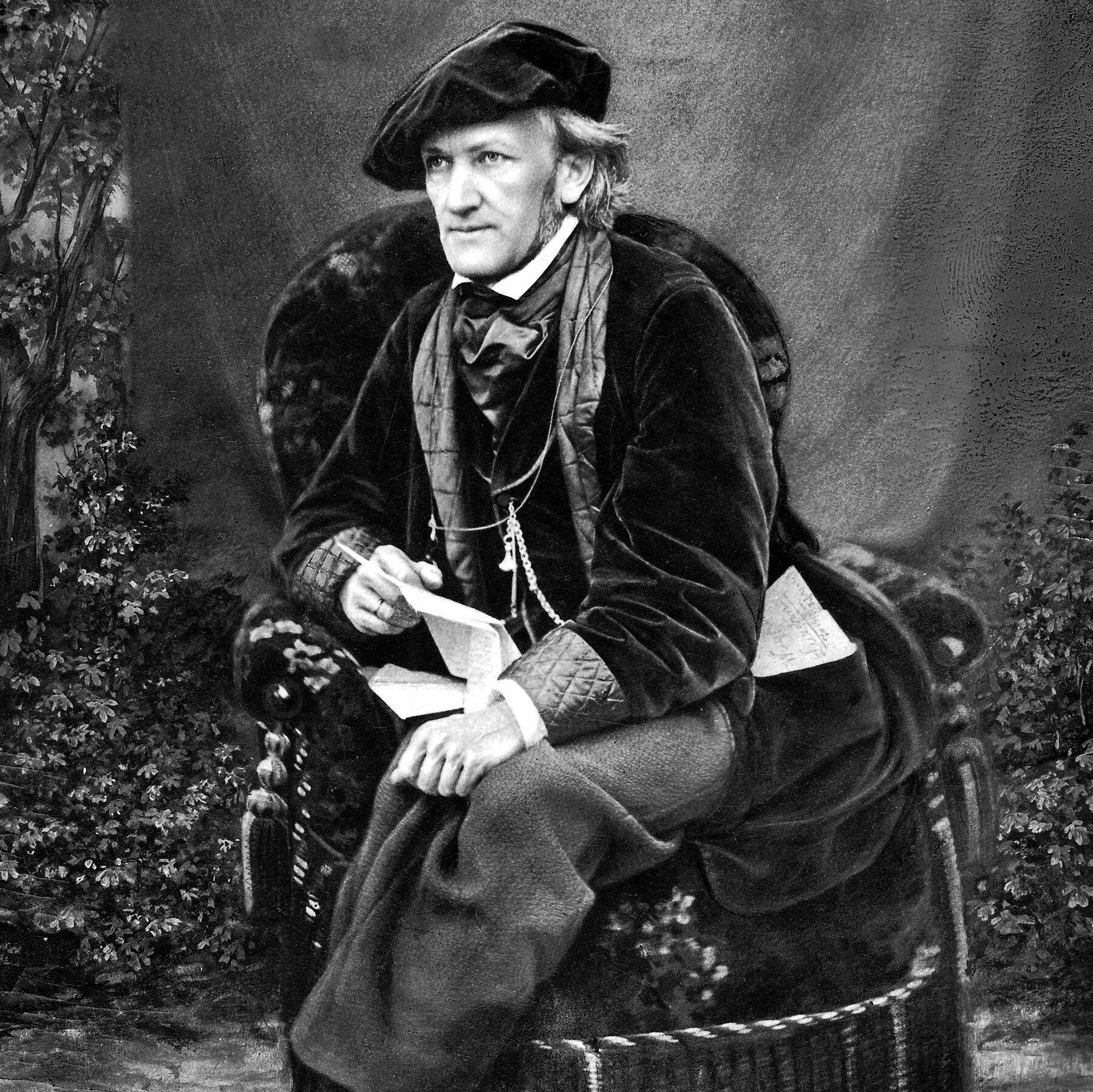New from Deutsche Grammophon
Live Concerts and Musical Transcendence in Deutsche Grammophon’s ‘Live from Salzburg’
In Deutsche Grammophon’s upcoming release Live from Salzburg, which features astounding recordings of Richard Wagner’s Wesendonck Lieder and Gustav Mahler’s Rückert Lieder, the power and range of Elīna Garanča’s voice are on full display. Her lower notes resonate with decisive power, while her dynamic control in the upper register allows her to follow the emotional trajectory of these works, sometimes mournful and weeping, sometimes enraptured, with skill and grace. This recording comes from two live performances at the Großes Festspielhaus in Salzburg, one in August of 2020 and the second in August of 2021. The title of this release centers the fact that it was recorded in a setting many of us once took for granted—seated in an auditorium full of other music lovers and the musicians themselves, allowing the vibrations from the instruments to reverberate through us directly—and yet, one whose specialness is now all too clear. Here is a recording of a concert celebrating the importance of live music that we can all enjoy from the comfort of our homes—a moment of time, originally rendered special by its impermanence, captured permanently as so many virtual bits of data. What we have then is a wonderful recording that leaves us with a few important unanswered questions about what classical music means in the 21st century.
Wagner’s Wesendonck Lieder, written between 1857 and 1858, are settings of poems written by Mathilde Wesendonck, who was married to one of Wagner’s financial supporters, and with whom he apparently had an extra-marital affair. The secretive nature of their relationship, and the emotional turmoil that resulted, appears to be the subject of these poems and the inspiration for Wagner’s passionate setting of them. Mahler, on the other hand, did not have any sort of personal relationship with Friedrich Rückert. These songs were written not only separately from one another, but also do not even comprise the entirety of Mahler’s Rückert settings. Mahler also set five more of Rückert’s texts in the 1904 songcycle Kindertotenlieder.
What these works have in common, however, is that neither was originally conceived as a song cycle with a fixed movement order nor were they originally written for a full orchestra. Over time, however, through performances of these songs in arrangement, they’ve come to exist as complete works after the fact, as proper song cycles. And yet, song cycles are not mere collections of songs; rather, we should understand that in grouping or juxtaposing these songs, some new meaning, something not present or emphasized in any of them individually, should come to light. In other words, it isn’t just that all of the songs have something in common and are thus grouped together, but instead, even songs that seem unrelated, by being placed in the context of one another, give rise to something completely new. This means with works like Wagner’s and Mahler’s here, where there is no fixed order to the movements, the meaning of these works, their narrative ebb and flow, is created in real time at the whim of the programmer.

The task is fairly straightforward with Wagner’s settings of Wesendonck’s poems. The circumstances in which Wagner set these poems and his relationship to their author create a clear enough scaffolding from which to build the rest of the song cycle. Indeed, I think the narrative of the Wesendonck Lieder is one we can only really understand after the fact, anyways. In large part due to its relationship with the opera Tristan und Isolde (1865), which Wagner was composing at the same time as the Wesendonck Lieder. So powerful was the opera’s force of gravity, Wagner himself labeled two of the settings (“Im Treibhaus” and “Träume”) as “studies” for the work. They are studies not only in composition, although it’s clear to see Wagner’s early experiments with the elliptical, suspension-laden harmonic language of Tristan and a number of its actual musical themes, but more importantly, one can also see the beginnings of its philosophical ideas. In the years preceding Wagner’s work on both Tristan and his settings of Wesendonck’s poetry, he had undergone a fairly important philosophical realignment, spurred on primarily by his contact with the works of philosopher Arthur Schopenhauer.
Schopenhauer’s work, inspired in part by Plato, Spinoza, Kant, and the philosophy of the late Vedas, describes a world comprised of cyclical, endless will or insatiable desires, what he called the Noumenon. The world as we know it, what Schopenhauer called the Phenomenon, is but a representation of that will, an “objectification” of it. The suffering that conscious beings experience results from an inability to escape the world of the Noumenon and of endless will, as well as the falseness of its representation in the Phenomenon. What Wagner found most compelling was Schopenhauer’s assertion that art has the ability to temporarily interrupt this suffering, by offering a brief moment of transcendence—art for art’s sake. Clearly these ideas had a fair amount of influence on the thinking of Mathilde Wesendonck as well, whose poems outline these same problems, even if the conclusions she arrives (or appears to arrive) at differ from both Schopenhauer’s and those that Wagner put forth in Tristan.
Take for example the poem “Stehe still!” (Be Still!), which is often performed as the second song in the cycle, which begs the “rushing, roaring wheel of time” to come to a stop long enough that the poem’s narrator might “in sweet forgetfulness…take the full measure of all [their] joy.” Wagner depicts this ancient, unstoppable wheel of time in a quick 6/8 with a fast-moving sixteenth-note figure and a stammering, almost-frantic vocal line. This gives way in the second half of the song to a gentler homophonic texture, and by the end, to a bright, tonally unambiguous cadence in C Major. It seems evident that Wesendonck’s wheel of time is a more poetic rendering of Schopenhauer’s Noumenon. She at one point refers to it as “urewige Schöpfung” (or “eternal creation,” although the “ur-“ prefix suggests something that’s somehow even more ancient than eternity), and begs for an end to its “Werden” to the act, or maybe more accurately the eternal state, of becoming. These same ideas resurface in the Act II love duet of Tristan und Isolde, where our lovers plead with the forces of night and day to come to a halt, that they might remain in each other’s arms for eternity. Although here, Wagner has taken Schopenhauer’s ideas a step further. Instead of moving from a busy, unsettled musical world to one of blissful harmony, in Act II of Tristan, Wagner conveys timelessness through heavy syncopation that completely obscures the underlying meter and leans in on harmonic ambiguity and dreamy elliptical cadences to depict the cyclical nature of will and desire.

In the next song “Im Treibhaus” (“In the Greenhouse”), she meditates on how this eternal becoming creates such a potent, yet vague feeling of dread. The poem’s narrator stares at the plants in a greenhouse, all of which seem to be silently screaming out in pain, and she intuits that they’ve somehow come to understand the true nature of things—that all things face the same bitter ending. By the end, they even seem to be crying. Wagner later reworked the same mournful music from this song into the third Act of Tristan, at the moment in which Tristan too faces the specter of death but has yet to reach enlightenment.
That enlightenment comes in Wesendonck’s poems in the fourth song, “Schmerzen” (Pain), where she asks why the sun must set every day. She finds consolation, ultimately, in the fact that the sun must set in order to rise once again. If death begets life, and pain joy, she concludes, then the suffering nature has imparted to her must also be a gift. Notably, Wagner and Wesendonck have swapped the significance of day and night. For Wesendonck, day represents happiness, warmth, and life—night the absence of all three. Wagner, on the other hand, treats day and night as clear analogues for Schopenhauer’s Phenomenon and Noumenon respectively. Tristan and Isolde dread the return of the day and the realities of the world and plead for endless night.
The last song “Träume” (Dreams) ends the song cycle in a sort of revery, where the narrator of these poems seems to have found a final sort of comfort in the transcendent world of dreams, much like Isolde realizes by the end of the opera that she and Tristan can only live together forever once they’ve transcended the false world of the living. Perhaps we can read this final retreat into the world of dreams as Wesendonck’s own poetic version of Schopenhauer’s aesthetic experience, the one possible respite from perpetual will.
And yet, it is ultimately the order these songs are performed in that allows us to read Wesendonck’s poems and Wagner’s later extrapolation of them in Tristan und Isolde this way. This is probably why the order of the songs in Wagner’s song cycle tend to be fixed, whereas few recordings of Mahler’s Rückert Lieder present the songs in the same order, and many of them even omit one or two altogether. Even Dorothea Walchshäusl, who wrote the liner notes for this recording, seems at a loss to find a way to draw these songs together under a single theme. She alludes to the text as a common thread (presumably meaning that they all stem from the same poet), but that the “individual mood that Mahler conjures up for each song” is “a far more striking characteristic.” But if we give the Mahler songs the same treatment as the Wagner, and look to the ordering of the songs for a hint, the final three, “Um Mitternacht” (At Midnight), “Blicke mir nicht in die Lieder” (Don’t Look at My Songs!), and “Ich bin der Welt abhanden gekommen” (I Have Lost Touch with the World), seem to center the importance of music as some form of respite from the horrors of the world, which at once is a nice subtle connection to the Wagner songs, but also seems inextricably linked to the circumstances that serve as the primary frame for Walchshäusl’s liner notes—the COVID-19 pandemic. Mahler’s songs are expressive and unique, and the color of his orchestral writing is on full display in these songs. Elīna Garanča and Christian Thielemann’s interpretation of the Mahler songs is exceptional, and the quality of this performance ultimately overshadows whatever nebulousness might arise from programming these songs, never necessarily intended to be understood as a single work, together.
For as much as Live from Salzburg leans in on its live-ness in its title, liner notes, and even its marketing copy, there is a conspicuous absence of applause at the end of each work. Beyond the occasional cough during the Mahler, there are very few auditory clues of the album being live. Perhaps this is intentional, an attempt to bookend each work in complete silence, to allow the works to exist beyond the mundane, even false world of Schopenhauer’s Phenomenon. And yet, I can’t help but think that in the end the appeals of concertgoing in the first place are all its living qualities, the fact that it can’t be pulled apart from its surroundings. Wagner and Schopenhauer could not have imagined high fidelity recordings or WAV files, but perhaps if they could have, it might have invited a moment of doubt in their conclusion that the world of aesthetics provided a way out of the endless suffering of Noumenon and Phenomenon. How can it be simultaneously true that what we want out of art is transcendence from the real world, and yet that after nearly two years of only being able to listen to music digitally, what so many of us seem to want is to be back in the midst of that real world? No doubt this is an exceptional recording of a marvelous set of concerts, and yet there remains a certain contradiction between its reverence for live, embodied performance and the insistence in its presentation on the kind of sonic flawlessness that only audio engineering can bring. Maybe this speaks ultimately to many of the broader problems of contemporary classical programming. Despite how much we love these works, and maybe to some extent because of our reverence for them, they aren’t timeless, and their ability to speak to the present is limited at best and fraught with contradictions at worst.
In preparing this review, I’ve spent a lot of time thinking through how best to frame the performance of the Mahler songs. Not just to speak to the circumstances under which they were composed, but how their performance now might change how we understand the songs themselves as well as our own time. The Wagner was fairly easy, although admittedly requires a fair amount of exposition to be able to articulate. But my (and Dorothea Walchshäusl’s) difficulty in trying to give Mahler this same treatment illuminates this fundamental problem, I think. Just as there is a barely noticeable rift between Deutsche Grammophon’s stated reverence for live music and the engineering decisions in the final product, anyone who sets out to write about classical music in the 21st century, regardless of the topic or audience, must first contend with, almost without noticing it most of the time, how in the world music which is ostensibly “universal” and “timeless” could possibly also be relevant to people in the here and now. “Which is it?” I guess, is the question I’m left with. Is music meaningful to us because it transcends the earthly realm, or do we enjoy it precisely because it’s made by other human beings in a particular place and time and only truly exists in the fleeting moments that its being performed? Is classical music worth listening to and writing about because it in particular rises above the confines and intentional obsolescence of fleeting musical styles, or is its grounded-ness in particular sociopolitical and economic contexts what makes it possible to even contextualize the here and now through its lens in the first place? I really don’t know, but I suspect that the truth is that these paradigms are too limited in the first place, and if we are ever to finally answer that perennial question of what role classical music should play in the contemporary world, we must first find a way past the contradictory roles we expect it to play in our lives.



